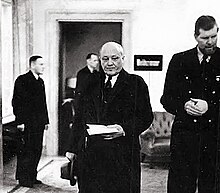Leland B. Morris
Leland B. Morris | |
|---|---|
 | |
| 1st United States Ambassador to Iran | |
| In office August 21, 1944 – May 20, 1945 | |
| President | Harry S. Truman Franklin D. Roosevelt |
| Preceded by | Louis G. Dreyfus, Jr. (as Minister) |
| Succeeded by | Wallace Murray |
| 2nd United States Ambassador to Iceland | |
| In office October 7, 1942 – May 10, 1944 | |
| President | Franklin D. Roosevelt |
| Preceded by | Lincoln MacVeagh |
| Succeeded by | Louis G. Dreyfus, Jr. |
| United States Ambassador to Germany | |
Acting, as chargé d'affaires | |
| In office October 1940 – December 11, 1941 | |
| President | Franklin D. Roosevelt |
| Preceded by | • Hugh R. Wilson • Alexander Comstock Kirk (Acting) |
| Succeeded by | James B. Conant (1955) |
| Personal details | |
| Born | Leland Burnette Morris February 7, 1886[1] Fort Clark, Texas, U.S. |
| Died | July 2, 1950 (aged 64) Washington, D.C., U.S. |
| Nationality | American |
| Occupation | Diplomat |
Leland Burnette Morris (February 7, 1886 – July 2, 1950) was an American diplomat. A native of Fort Clark, Texas, he was the first United States Ambassador to Iran, serving that post from 1944 to 1945. Earlier he was United States Ambassador to Iceland from 1942. Morris served many other diplomatic posts including American Consul General in Jerusalem in 1936, American Consul General in Vienna from 1938 to 1940 after the German annexation of Austria and the American chargé d'affaires in Germany during the outbreak of official American involvement in World War II.
His mother was Susan Frances (née Reece) Morris and his father was Louis Thompson Morris, a colonel in the United States Army. During his post in Vienna, Morris is credited by the Jewish-Austrian author Felix Salten for ensuring his and his family's protection from persecution by Nazi authorities.[2] Salten and his wife Ottilie Metzl were able to emigrate to Switzerland due to their daughter Anna-Katharina having married a Swiss man.
Service in Germany during World War II[]
Morris became the American Chargé d'affaires in Germany in October 1940. Prior to the Japanese attack on Pearl Harbor on December 7, 1941, the United States was officially neutral and retained a diplomatic corps in Berlin. This included diplomat George Kennan. Morris, serving as Chargé d'Affaires, was the highest-ranking American diplomat in Germany at the time (the last United States Ambassador, Hugh R. Wilson, was recalled in 1938 in protest of Kristallnacht). On December 11, after the Pearl Harbor attack, German Foreign Minister Joachim von Ribbentrop summoned Morris to his office and read to Morris Germany's formal declaration of war and addressed him by accusing the United States of violations of neutrality and other acts of war.[3] According to Kennan, after reading the declaration Ribbentrop screamed at Morris, "Ihr Präsident hat diesen Krieg gewollt; jetzt hat er ihn" ("Your President has wanted this war, now he has it"), turned on his heels and left the room.[4][5] Official diplomatic relations between the United States and Germany thus ended.
On December 14, most of the American diplomatic corps still in Germany, including Morris, Kennan, and Associated Press journalist Louis P. Lochner were detained by German authorities and held at a former resort near Bad Nauheim.[6] In February 1942, through Swiss diplomats, Morris reported conditions of the detainment to his superiors in Washington. While there was relative freedom of movement around the resort grounds, he wrote of food shortages and weight-loss amongst the group.[6] In May, Morris and the other Americans were transferred to Lisbon, Portugal where they departed for New York aboard the SS Drottningholm and exchanged for German prisoners being held in the United States.[6]
Death[]
Morris died on July 2, 1950, at the age of 64, in Washington, D.C.[7]
References[]
- ^ United States Department of State (1913) Register of the Department of State United States Government Printing Office
- ^ Salten, Felix (2006). Felix Salten: Schriftsteller, Journalist, Exilant. Holzhausen Verlag. p. 67. ISBN 385493128X.
- ^ Read, Anthony (2004). The Devil's Disciples: Hitler's Inner Circle. W. W. Norton & Company. pp. 783. ISBN 978-0-393-04800-1.
- ^ Keenan, George F. (2020) Memoirs 1925-1950. p.96 Plunkett Lake Press.
- ^ The essence of Ribbentrop's comment to Morris, without the descriptive commentary, is confirmed by Bloch, Michael (1992) Ribbentrop: A Biography. New York: Crown. p.347 ISBN 0-517-59310-6 citing Staff (1954) Documents on German Foreign Policy - Series D - Volume XIII - June 23 - December 11 1941 pp.1004-1005. United States Government Printing Office, Telegram No. 577 (December 11, 1941) from "Schmidt"
- ^ a b c Dowling, Timothy C. (2004). Personal perspectives:World War II. ABC-CLIO. p. 276. ISBN 978-1-85109-575-9.
- ^ Staff (July 5, 1950). "Leland B. Morris, 64, U.S. Ex-Envoy to Iran". The New York Times. ISSN 0362-4331. Retrieved April 7, 2019.
External links[]
- Ambassadors of the United States to Germany
- Ambassadors of the United States to Iran
- Ambassadors of the United States to Iceland
- People from Kinney County, Texas
- 1886 births
- 1950 deaths
- United States Foreign Service personnel
- 20th-century American diplomats
